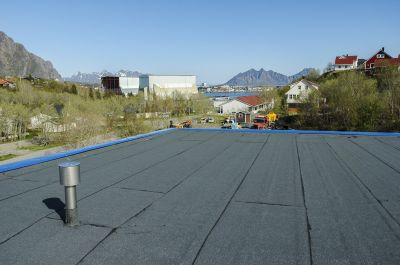Top-Rated Products for Single Ply Roof Replacement Projects
Compare leading materials and tools that help achieve high-quality results in single ply roof upgrades.
 Single ply roof replacements require careful selection of materials and products to ensure durability, weather resistance, and ease of installation. These roofing systems are commonly used in commercial and industrial settings due to their lightweight nature and versatile application options. When considering products for a single ply roof replacement, it is essential to evaluate the compatibility of membrane materials, adhesives, and accessories to achieve a seamless and long-lasting roof system. Proper installation techniques and quality components can significantly influence the performance and lifespan of the roof.
Single ply roof replacements require careful selection of materials and products to ensure durability, weather resistance, and ease of installation. These roofing systems are commonly used in commercial and industrial settings due to their lightweight nature and versatile application options. When considering products for a single ply roof replacement, it is essential to evaluate the compatibility of membrane materials, adhesives, and accessories to achieve a seamless and long-lasting roof system. Proper installation techniques and quality components can significantly influence the performance and lifespan of the roof.
Top Overall Option
Flexible Membrane Roofing System
A versatile and durable membrane system designed for single ply roof replacements, offering compatibility with various adhesives and accessories. Its ease of installation and adaptability make it a popular choice among roofing professionals, providing a reliable weather-resistant barrier. The membrane's flexibility allows for expansion and contraction, accommodating building movements and temperature fluctuations, which can help maintain long-term performance.
Types of Products For Single Ply Roof Replacements
Thermoplastic Polyolefin (TPO) Membranes
A thermoplastic membrane known for its UV resistance and ease of welding during installation.
Polyvinyl Chloride (PVC) Membranes
A flexible, chemical-resistant membrane suitable for various roofing environments.
EPDM Rubber Membranes
A durable, synthetic rubber membrane valued for its weather resistance and flexibility.
Seam Tapes and Welding Rods
Products used to create secure, watertight seams between membrane sheets.
Roofing Adhesives
Specialized adhesives designed to bond membranes to substrates and accessories reliably.
Insulation Boards
Thermal insulation panels that improve energy efficiency and provide a stable base for membrane installation.
Edge Metal Flashing
Metal components that protect roof edges and transitions from water infiltration.
Fasteners and Plates
Securement devices for attaching membranes and accessories to the roof deck.
Roof Drains and Vents
Components that facilitate water removal and ventilation within the roofing system.
Protective Coatings
Surface coatings that enhance UV resistance and extend membrane lifespan.
Ballast Materials
Materials like pavers or gravel used to hold membranes in place and provide weight stability.
Repair Patches and Kits
Products designed for patching and maintaining the integrity of the membrane over time.
Vapor Barriers
Materials that prevent moisture migration into the roofing system, protecting insulation and structure.
Roofing Sealants
Sealants used to seal penetrations, seams, and flashing details against water ingress.
Fire-Resistant Membranes
Membranes designed with fire-resistant properties to meet safety standards.
Popular Choices
Widely used for their ease of installation and versatility across different roofing projects.
Chosen for their chemical resistance and durability in various climates.
Recognized for its flexibility and weather resistance, suitable for large commercial roofs.
Devices used to fuse membrane seams securely, ensuring watertight joints.
Adhesives formulated for strong bonds and reliable membrane installation.
Popular for improving energy efficiency and providing a stable base for membrane layers.
Commonly used to protect roof perimeters and transitions from water intrusion.
Essential for effective water removal and preventing ponding issues.
Applied to extend membrane life and improve UV resistance.
Pavers and gravel options that provide stability and secure membranes in place.
Convenient solutions for minor damages and maintenance tasks.
Used to prevent moisture migration and protect insulation layers.
Sealants for sealing penetrations and seams effectively.
The primary material used in single ply roofing is a flexible membrane that comes in various types, including thermoplastic polyolefin (TPO), polyvinyl chloride (PVC), and ethylene propylene diene monomer (EPDM). Each type offers unique characteristics such as UV resistance, flexibility, and ease of repair. Complementary products such as seam tapes, adhesives, and insulation boards are also critical to ensure a secure and weather-tight installation. Selecting products that are compatible and designed for the specific membrane type can help prevent issues like leaks, tearing, or membrane degradation.
In addition to the membrane and adhesives, accessories like edge metal, fasteners, and flashing components play a vital role in completing a reliable roof system. Properly chosen products can facilitate a smoother installation process and improve the overall integrity of the roof. It is advisable to consult manufacturer specifications and industry standards when selecting these components to ensure they meet the necessary requirements for your project. Regular maintenance and inspection with suitable products can also extend the life of the roof and help identify potential issues early.
Overall, choosing the right products for single ply roof replacements involves a balance of quality, compatibility, and suitability for the specific application environment. Investing in reliable materials and components can contribute to a durable roofing system that performs well over time, providing peace of mind for building owners and facility managers alike.
Key Buying Considerations
- Compatibility of membrane material with adhesives and accessories.
- Climate and weather conditions in the installation area.
- Ease of installation and available tools or equipment.
- Membrane thickness and flexibility requirements.
- UV resistance and durability of the membrane.
- Compatibility with existing roofing components or systems.
- Warranty and manufacturer support offerings.
- Ease of repair and maintenance options.
- Fire resistance and safety standards compliance.
- Cost and availability of products in your region.
- Environmental conditions such as wind uplift and ponding potential.
- Ease of seam welding or bonding techniques required.
- Weight and ballast requirements for membrane stability.
- Compatibility with insulation and underlying substrates.
- Long-term performance expectations and industry standards.
